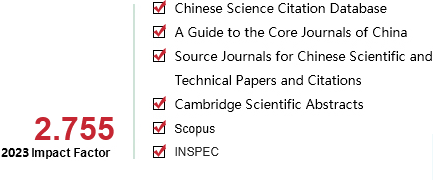[1]YAN Jiameng,XU Libo,LI Xingsen,et al.Dynamic analysis method of importance of science and education interpersonal network nodes based on extension clustering[J].CAAI Transactions on Intelligent Systems,2019,14(5):915-921.[doi:10.11992/tis.201811012]
Copy
Dynamic analysis method of importance of science and education interpersonal network nodes based on extension clustering
CAAI Transactions on Intelligent Systems[ISSN 1673-4785/CN 23-1538/TP] Volume:
14
Number of periods:
2019 5
Page number:
915-921
Column:
学术论文—智能系统
Public date:
2019-09-05
- Title:
- Dynamic analysis method of importance of science and education interpersonal network nodes based on extension clustering
- Keywords:
- complex network; node importance; multi-attribute; extenics; extension clustering; extension theory; matter element; correlation function
- CLC:
- TP301.6
- DOI:
- 10.11992/tis.201811012
- Abstract:
- At present, the identification of the influence of key nodes in complex social network is usually static and does not involve the analysis of dynamic changes. The extension clustering method is used to quantitatively analyze the interpersonal network of science and education under dynamic changes. First, the importance of each node is calculated by multi-attribute decision-making method. Then the comprehensive importance of the node is calculated by the coefficient of variation weight method. It is then classified, and the standard positive domain and the positive domain are acquired. The extension correlation function is used to calculate the degree of association between each node and each level. The level with the highest correlation value is the corresponding level of the node. Finally, the importance level of the same social network node at different time points is analyzed. The extension clustering method aims to dynamically determine the importance of network nodes. Finally, the effectiveness of the method is verified using an example.
- References:
-
[1] ADAMIC L A, HUBERMAN B A, BARABÁSI A L, et al. Power-law distribution of the world wide web[J]. Science, 2000, 287(5461):2115.
[2] 于会, 刘尊, 李勇军. 基于多属性决策的复杂网络节点重要性综合评价方法[J]. 物理学报, 2013, 62(2):020204 YU Hui, LIU Zun, LI Yongjun. Key nodes in complex networks identified by multi-attribute decision-making method[J]. Acta physica sinica, 2013, 62(2):020204
[3] ALBERT R, JEONG H, BARABÁSI A L. Error and attack tolerance of complex networks[J]. Nature, 2000, 406(6794):378-382.
[4] FREEMAN L C. A set of measures of centrality based on betweenness[J]. Sociometry, 1977, 40(1):35-41.
[5] WEHMUTH K, ZIVIANI A. DACCER:distributed assessment of the closeness centrality ranking in complex networks[J]. Computer networks, 2013, 57(13):2536-2548.
[6] KITSAK M, GALLOS L K, HAVLIN S, et al. Identification of influential spreaders in complex networks[J]. Nature physics, 2010, 6(11):888-893.
[7] PASTOR-SATORRAS R, VESPIGNANI A. Epidemic spreading in scale-free networks[J]. Physical review letters, 2001, 86(14):3200-3203.
[8] FREEMAN L C. Centrality in social networks conceptual clarification[J]. Social networks, 1979, 1(3):215-239.
[9] OPSAHL T, AGNEESSENS F, SKVORETZ J. Node centrality in weighted networks:generalizing degree and shortest paths[J]. Social networks, 2010, 32(3):245-251.
[10] SABIDUSSI G. The centrality index of a graph[J]. Psychometrika, 1966, 31(4):581-603.
[11] CLAUSET A, SHALIZI C R, NEWMAN M E J. Power-law distributions in empirical data[J]. SIAM review, 2009, 51(4):661-703.
[12] CARMI S, HAVLIN S, KIRKPATRICK S, et al. A model of Internet topology using k-shell decomposition[J]. Proceedings of the national academy of sciences of the United States of America, 2007, 104(27):11150-11154.
[13] 杨春燕, 蔡文. 可拓学[M]. 北京:科学出版社, 2014.
[14] 杨国为, 王守觉. 模式可拓识别及其神经网络模型[J]. 哈尔滨工业大学学报, 2006, 38(7):1129-1132 YANG Guowei, WANG Shoujue. Pattern extension recognition and its neural network model[J]. Journal of Harbin Institute of Technology, 2006, 38(7):1129-1132
[15] XU Libo, LI Xingsen, PANG Chaoyi. Uncertain multiattribute decision-making based on interval number with extension-dependent degree and regret aversion[J]. Mathematical problems in engineering, 2018, 2018:6508636.
[16] XU Libo, LI Xingsen, SHAO Junkai, et al. Extension dependent degree method with mapping transformation for three-parameter interval number decision making[J]. Mathematical problems in engineering, 2018, 2018:1831086.
[17] 王晓磊, 杨岳湘, 何杰. 基于多重属性的P2P网络节点重要性度量方法[J]. 计算机应用, 2014, 34(S2):7-10, 19 WANG Xiaolei, YANG Yuexiang, HE Jie. P2P network node importance measurement method based on multi-attribute[J]. Journal of computer applications, 2014, 34(S2):7-10, 19
[18] 胡庆成, 尹龑燊, 马鹏斐, 等. 一种新的网络传播中最有影响力的节点发现方法[J]. 物理学报, 2013, 62(14):140101 HU Qingcheng, YIN Yanshen, MA Pengfei, et al. A new approach to identify influential spreaders in complex networks[J]. Acta physica sinica, 2013, 62(14):140101
[19] 蔡文, 杨春燕, 陈文伟, 等. 可拓集与可拓数据挖掘[M]. 北京:科学出版社, 2008:6.
[20] 杨春燕. 可拓创新方法[M]. 北京:科学出版社, 2017:3.
[21] 蔡文, 杨春燕. 可拓学的基础理论与方法体系[J]. 科学通报, 2013, 58(13):1190-1199 CAI Wen, YANG Chunyan. Basic theory and methodology on Extenics[J]. Chinese science bulletin, 2013, 58(13):1190-1199
- Similar References:
Memo
-
Last Update:
1900-01-01
